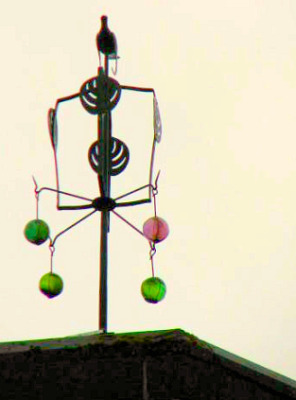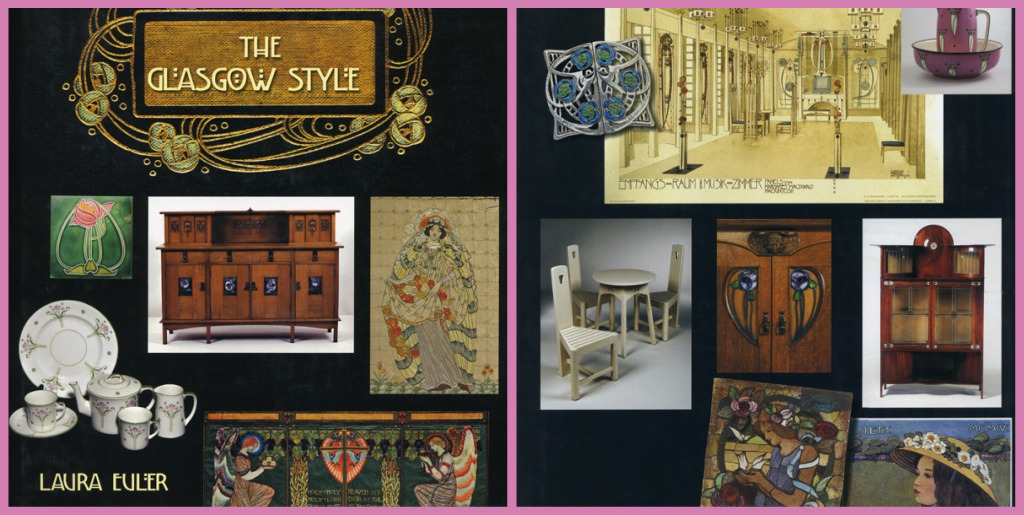
- Germany – Art Nouveau – Sheet 3 Stamps
As a “suite” to the great post that Mairiuna wrote about Mrs Kate Cranston’s tearooms, revealing Charles Rennie Mackintosh as the artist behind the magnificient decorative style of its interiors, I would like to emphasize today on the symbolism that lies underneath Mackintosh’s creative designs.
But first, to put ourselves into context, let’s step back a century ago…
In the late 19th century, as a reaction to “copyism” with machine made products of industrialism, an international artistic style called ‘Art Nouveau’ emerged into the cultural life of many countries. The artistic revolution was in favor of returning to natural forms and individual craftmanship.
The purpose of this “new style” was to unite architecture and decorative art in order to create high quality design based on writhing plants forms.
Over the span of approximately twenty years, from 1890 to 1910, the enthusiasm for this creative style is clearly visible in many areas of the Arts, mainly painting, architecture, fashion, interiors, posters, and handicrafts.
In the realm of Architectural art, the leading light was the Glaswegian Scot Charles Rennie Mackintosh.
His best known work is the Glasgow School of Art, which by the way 😉 appears on a Great Britain stamp set issued to commemorate Glasgow’s 1990 designation of the European City of Culture.
Art school founded in 1840 as the School of Design in Ingram Street, Glasgow. In 1869 it moved to its present site in Sauchiehall Street, and in 1896 Charles Rennie Mackintosh won a competition to design a new building. This was erected in 1897–9, with a library block and other extensions added in 1907–9.
Together they form one of the most original and dramatic works of architecture of the period anywhere in Europe. At this time the School was enjoying its golden age, under the directorship (1885–1918) of the painter Francis ( Fra) Newbery (1855–1946), who had admirable skill as an administrator and a flair for recognizing and encouraging talent. He had good connections abroad and helped the School to win an international reputation.
It continues to enjoy high status and produced a particularly outstanding crop of graduates in the 1980s, including the painters Steven Campbell (1953– ), Stephen Conroy (1964– ), and Alison Watt (1965– ). Their work marks a return to an interest in figurative art after the ‘anything goes’ 1970s.
IAN CHILVERS. “Glasgow School of Art.” The Oxford Dictionary of Art. 2004. Encyclopedia.com. (March 14, 2010). http://www.encyclopedia.com/doc/1O2-GlasgowSchoolofArt.html
While studying at the School of Art, Mackintosh met sisters, Frances and Margaret MacDonald and they were to form a group along with Herbert MacNair, to become known internationally as the Glasgow Four.
On our trip to Scotland in 2007, it was with great excitement that we arrived on Sauchiehall Street, to visit and admire one of his greatest masterpiece! We took pictures of the elements composing the building’s facade, and upon examination of these mysterious, or should I say, mystical elements, I wondered about the meaning that Charles Rennie Mackintosh, his wife Margaret, and the group all together were trying to convey through the symbols of the tree, the rose and the flower heads, to name just these few.
I happily found a very in depth answer to my question in the article written by A Glasgow Gnostic on his blog. A must read for everyone interested in Charles Rennie Macintosh and the Art Nouveau movement! An extract is quoted below.
Mackintosh was searching in his work for “the soul that lies beneath appearances” and he found that this soul was best expressed through a poetic mood of symbolic illumination. In the 1890s and early 1900s a spiritual atmosphere pervaded Scotland’s cultural life, and many influential artists and writers were either group members or followers of Rosicrucian, Theosophical, or Gnostic thought. There are many indications that the Glasgow Four’s ideas and inspirations were deeply affected by such movements
The Glasgow Four used the rose so often as an iconic symbol that it was characteristic of them. The rose is the grandest and noblest of nature’s symbols. It is the symbol of Nature, of the ever prolific and virgin Earth, or Isis, the mother and nourisher of man.
From his earliest 1894 pencil and color wash drawings Mackintosh depicted the Tree of Life. The sculpted relief carving above the entrance to the Glasgow School of Art portrays two maidens guarding a central tree, which is an emblem, both of the Tree of Life and the Tree of Knowledge. Mackintosh also sets another Tree of Life within the oval glass insets on the doors of the ground floor, while the library is closely linked with the Tree of Knowledge in a series of visual puns (leaves on balusters, leaves in books).
The meaning of Mackintosh’s stylized abstract concepts seems to have eluded many commentators, but they are more ethereal and less eerie or melancholic than the images of the sisters and MacNair.
Mackintosh said, “You must be independent, shaking off all the props tradition and authority offer you, and go on alone. The artist’s motto should be, ‘I care not the least for theories or for this or that dogma so far as the practice of art is concerned—but take my stand on what I consider my personal ideal.'”
From the highest antiquity trees were connected with the gods and mystical forces in nature. Every nation had its sacred tree, with its peculiar characteristics and attributes based on natural, and also occasionally on occult properties, as expounded in the esoteric teachings.” The symbol for sacred and secret knowledge in antiquity was a tree; hence dragons (symbols of wisdom) guard the Trees of Knowledge.
Among the many representations of the rose, the cross, the square, and the circle, it is the tree, in various stylized forms, that dominates Mackintosh’s art and architecture.
In his architectural lectures, Mackintosh quoted from W. R. Lethaby’s Architecture, Mysticism and Myth, which propounded a cosmic symbolism whereby a tree is both a symbol of the universe and a basic form of building construction; so the Tree of Life now becomes a symbol for inspired architecture.
Mackintosh wrote: “You ask how you are to judge architecture? Just as you judge painting or sculpture form, color, proportion, all visible qualities—and the one great invisible quality in all art, soul“.
Talk soon,
Janice

.
.









Hello. I’m a Los Angeles based artist and designer, and I’ve recently created a ‘do it yourself’ wall mural based on the work of Charles Rennie Mackintosh. I’m not sure if it’s appropriate for your blog, but I’m submitting it for your consideration. Thank you. Romi Cortier. http://www.youtube.com/watch?v=JB9ZRyLb7jA
[…] https://www.scotiana.com/glasgow-school-of-art-an-architectural-expression-of-charles-rennie-mackinto… […]
[…] of Art, Charles Rennie Mackintosh, 1896, Painting by Dugal Cameron – Postcard) Available at: https://www.scotiana.com/glasgow-school-of-art-an-architectural-expression-of-charles-rennie-mackinto… (Accessed: 5 March […]
[…] of Art, Charles Rennie Mackintosh, 1896, Painting by Dugal Cameron – Postcard) Available at: https://www.scotiana.com/glasgow-school-of-art-an-architectural-expression-of-charles-rennie-mackinto… (Accessed: 5 March […]